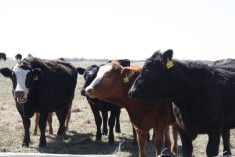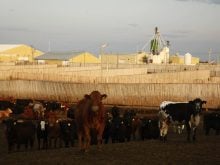This cattle market information is selected from the weekly report from Canfax, a division of the Canadian Cattlemen’s Association. More market information, analysis and statistics are available by becoming a Canfax subscriber by calling 403-275-5110 or at www.canfax.ca.
Fed market strong
The fed market has outperformed expectations this summer and dropped only six percent from highs in June. September is not traditionally a strong month for the fed market, but prices have been stable, averaging in the low $230s per hundredweight.
Read Also

Bunge’s crop mix is changing
Bunge has predominantly been a soybean processing firm, but that’s about to change after the merger with Viterra with softseed processing and grain merchandising gaining ground.
From a seasonal perspective, the market is carving out summer price lows. Last week dressed sales were reported at $390 per cwt. delivered. Cattle were being scheduled anywhere from the week of Oct. 9 to Oct. 30 delivery.
No cash sales to the United States were confirmed, but U.S. packers were looking at formula pricing western Canadian fed cattle. Over the past two weeks there have been reports of a few cattle committed to U.S. packers. These cattle will be priced off the five-area average U.S. fed price.
Western Canadian fed slaughter for the week ending Sept. 16 totalled slightly more than 46,000 head, the largest slaughter volume seen this year.
Not only have slaughter rates increased, but more Canadian fed cattle are also being shipped south. Based on weekly U.S. import data, Canadian fed cattle shipments to the U.S. were the second largest seen this year, totalling more than 8,800 head.
Seasonally, carcass weights continue to trend larger. Western Canadian steer carcass weights have averaged more than 935 pounds for the past couple of weeks. For the middle of September, western Canadian carcass weights are the second largest on record.
In Ontario, dressed sales were reported at $395 per cwt. delivered, $3 per cwt. higher than the previous week.
In the U.S., dressed sales in Iowa and Nebraska were US$292-$293 per cwt., fully steady with the previous week. Live sales in the northern feeding states were from $184-$185 per cwt., while southern regions traded at $183, fully steady.
Beef cow slaughter volumes are running below last year and below the five-year average.
Cow prices lower
Non-fed prices trended seasonally lower last week on ample offerings and waning cut-out values. Alberta D2 slaughter cow prices slipped $3.50 per cwt. lower than the previous week to average $135.10 per cwt., and D3 cows eased more than $4 per cwt. lower to $123.75.
Dressed cow bids realigned sharply lower to $255-$265 per cwt. delivered. Butcher bull prices were $4.43 per cwt. lower than last week, averaging $155 per cwt.
Western Canadian non-fed slaughter for the week ending Sept. 16 was 14 percent larger than the previous week at 7,452 head and year to date was nine percent larger, totalling 266,831 head. Supplies will continue seasonally ample, and price spreads should widen as interest in feeder cows improves.
Good feeder demand
Light Alberta calves traded mixed last week, with steers lighter than 500 lb. gaining significant price momentum, while similar weight heifers traded lower. Good demand continued for 600-800 lb. feeders, and prices rallied $3-$4 per cwt. higher than the previous week. Large feeders heavier than 800 lb. saw prices steady to stronger.
Thanks to a couple of special calf sales, weekly Alberta auction volumes surged 149 percent larger than the previous week to 100,136 head and were 73 percent larger than the same week last year. Since reporting began in 1990, a weekly auction volume over 100,000 head has never been reported ahead of the third week of October.
Many of the feeders offered on electronic sales were priced for deferred fourth quarter delivery. Deteriorating pasture conditions are also responsible for some of the early non-fed and feeder marketings. Year-to-date auction volumes were 17 percent larger than a year ago, totalling 1,088,030 head.
Canadian feeder exports to the U.S. for the four-day week ending Sept. 9 were 11 percent smaller than the previous week at 4,769 head. Year-to-date feeder exports were 30 percent lower than year ago, totalling 113,562 head.
All weights of stockers and feeders have established historic highs over the past three weeks, and all calves, with the exception of 300-500 lb. heifers, established new highs again last week.
Cut-out price softens
In U.S. beef trade, cutouts softened last week. Choice cutouts ended the week off one percent to close just below US$302 per cwt. There are reports that U.S. packers are losing money on every head processed, and they will be looking to turn that around through a reduction in kill rates and cooler cleanings.














